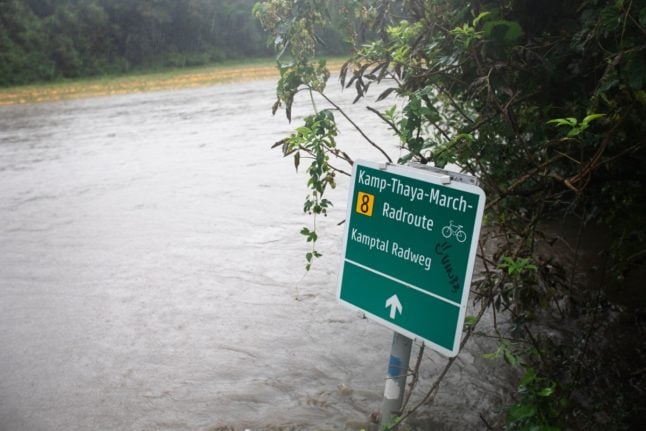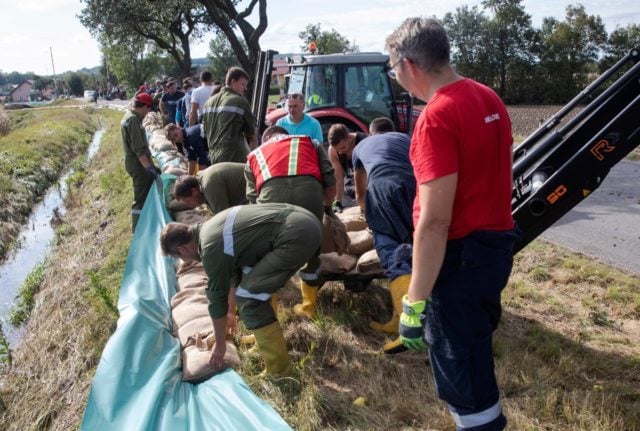The severe flooding across Austria caused by the relentless rainfall over the weekend and on Monday has wreaked havoc on the nation’s transport systems, leaving commuters and travellers scrambling to adapt.
The storm’s effects are being felt nationwide, from disrupted metro services in Vienna to closed motorways and suspended rail services.
Vienna metro network hit hard
The capital’s metro system, Wiener Linien, has been particularly affected, with several vital lines running with severe restrictions. Water levels on the Vienna River and Danube Canal have fluctuated, requiring constant flood protection efforts.
READ ALSO: Weather forecast: When will the torrential rain in Austria stop?
As a result, services on the U4, U6, U3, and U2 lines were partially suspended. While the U6 could only operate between Floridsdorf and Westbahnhof and between Meidling and Siebenhirten, the U4 was limited to the section between Heiligenstadt and Friedensbrücke. Similarly, the U3 was running from Ottakring to Schlachthausgasse, leaving Simmering without service, and the U2 was restricted to running between Seestadt and Taborstraße.
“Die Unwetterlage in Niederösterreich, in Wien und in der Steiermark verschärft sich am Sonntagnachmittag weiter – das gesamte Bundesland NÖ wurde zum Katastrophengebiet erklärt. In Niederösterreich kam ein Feuerwehrmann beim Einsatz ums Leben.”
🇦🇹♥️https://t.co/bvjZBlVjxs pic.twitter.com/M6oGZd3c17— Viktoria Germania (@Germania737) September 15, 2024
Wiener Linien has indicated that normal operations may not resume until mid-week, as flood protection measures like dam beams and sandbags were still in place.
Depending on how the rain and water levels develop, additional delays or restrictions are possible. Commuters should check for updates via the WienMobil app or the operator’s website.
Nationwide rail and road chaos
Floods have also affected Austria’s national railway, ÖBB, with delays and cancellations expected to persist until at least Thursday, September 19th.
The ÖBB issued travel warnings urging passengers to avoid non-essential journeys, and some major routes were suspended entirely.
READ ALSO: What’s the cause of Austria’s ‘unprecedented’ rainfall and flooding?
On the western rail line between Vienna and Linz, services were halted on Monday and Tuesday due to flooding, leaving WESTbahn passengers unable to travel. Although WESTbahn tickets were temporarily accepted on ÖBB trains between Vienna and Salzburg, travellers were asked to prepare for disruptions and extended journey times.
The situation on the roads isn’t much better. While some motorway closures have been lifted, others remained, particularly in Lower Austria, where almost 300 roads were currently impassable. Drivers are advised to avoid travel where possible and to check local road conditions before setting off.
You can see a list of all road closures HERE.
#Autobahn bei Guntramsdorf #NÖ nahe #Wien. So schaut’s momentan aus bei uns. Danke an alle Einsatzkräfte da draußen. 🙏🙏🙏 #Hochwasser in #Österreich pic.twitter.com/FCs4ZwFJbM
— Christine Neumeyer (@ChNeumeyer) September 16, 2024
Boats and river cruises stranded
The flooding has as would be expected hit travel on Austria’s waterways. In Vienna, a Swiss river cruise ship, the Thurgau Prestige, remained docked, with its passengers unable to disembark due to high water levels.
Since Saturday, 102 passengers and 40 crew members had been stranded on board.
Authorities have not yet confirmed when it will be safe for them to leave the ship.
READ ALSO: Floods latest: Two men found dead in their homes in Lower Austria
Pedestrians also impacted
Even walking in some areas of Austria has been made dangerous by the storms. In Vienna, public parks were closed to reduce the risk of falling trees, while footpaths and public spaces were at risk of water damage or further flooding.
Residents are being urged to stay indoors where possible.
READ NEXT: Do workers in Austria have the right to stay at home amid floods crisis?




 Please whitelist us to continue reading.
Please whitelist us to continue reading.
Member comments